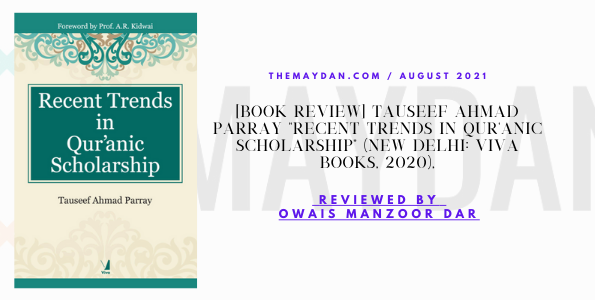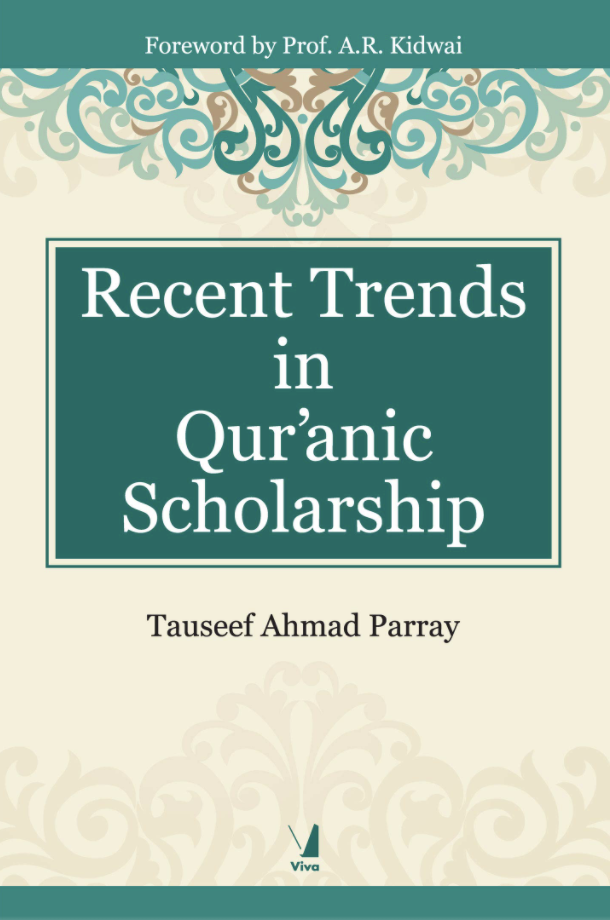
[Book Review] Tauseef Ahmad Parray, Recent Trends in Qur’anic Scholarship (New Delhi: Viva Books, 2020), xxxv + 304 pages. | Reviewed by Owais Manzoor Dar
The Qur’anic studies is a rich academic sub-field of Islamic studies to which Muslims as well as non-Muslims have contributed extensively. The academic study of the Qur’an is only the latest in centuries-long endeavours to explore the varied aspects of the Qur’an. The present century has witnessed broad developments and a growth of approaches as Qur’anic studies has emerged as a vibrant field of research globally, which is the focus of Tauseef Ahmad Parray’s Recent Trends in Qur’anic Scholarship.
“Parray’s work focuses on twenty-first century scholarly engagement with the Qurʾan and attempts to explore some of its most recent trends by evaluating recent works, teaching and research in the field of Qur’anic studies.”
Parray’s work focuses on twenty-first century scholarly engagement with the Qurʾan and attempts to explore some of its most recent trends by evaluating recent works, teaching and research in the field of Qur’anic studies. The book divides into three major parts; the first part (chapters 1-5) discusses certain Qur’anic concepts that repeatedly find place in contemporary discussions, like Ihsan (moral excellence) and Shura (group consultation). The first chapter studies dimensions of Ihsan in the Qur’an and Prophetic traditions. The second chapter studies the concept of Shura, its varied interpretations, particularly in Indo-Pak exegesis and how these interpretations contribute to the Shura-Democracy nexus. The cognitive concepts, Aql (rationality); Taffakkur (reflection) and their intersection with Ilm (knowledge) and its contemporary relevance is examined in third chapter. The last two chapters of Part I discuss the “rise and fall of nations” and the social ethics vis-à-vis the institution of family. The author argues that there are four major factors which influence the rise and fall of nations, and these are: “justice and injustice; unity and disunity; neglect of the principal of Amr Bil Mar’uf wa Nahy àn al-Munkar; and moral corruption” (72). Maulana Mawdudi, Murtaza Mutahhari, Muhammad Gholam Rasul and Ziauddin Sardar’s views on the fall and rise and fall of nations are brought to bear on these discussions. The author concludes that the solution to contemporary domestic as well as societal problems “lies in following the principles and guidelines prescribed in the Qur’an and Ahadith” (87).
The second part (Chapters 6-9) discusses twenty-first century scholarly contributions in the field of Qur’anic studies. Among Muslim academics, he studies the works of Abdur Raheem Kidwai (India), Abdullah Saeed (Australia) and Ziauddin Sardar (UK), and among non-Muslim academics he studies Jane D. McAuliffe (USA) and Andrew Rippin (Canada). The author provides a succinct and precise introduction to their important works, along with a brief profile.
“The final part (chapters 10 and 11) provides a review of some recent (published between 2010 to 2019) works on different aspects of the Qur’anic studies.”
The final part (chapters 10 and 11) provides a review of some recent (published between 2010 to 2019) works on different aspects of the Qur’anic studies. In the first section, the author discusses the merits as well as demerits of three English translations of the Qur’an, namely Daoud William Peachey and Maneh al-Johani’s The Qur’an: The Final Book of God – A Clear English Translation of the Glorious Qur’an (2012), Abdur Raheem Kidwai’s What is in the Qur’an (2013), and Waleed B. al-Amri’s The Luminous Qur’an (2019). The author notes that Peachey and al-Johani’s work provides a useful introduction of “the structure, and the content, miraculous nature, revelation, preservation and interpretations of the Qur’an.” Kidwai’s translation, rather than offering a literal translation of the Qur’an, “presents and paraphrases in easy simple and straightforward English, while striving to retain its original message”, Parray argues (200). Some of its unique features are “the 200 brief explanatory footnotes, a bibliography and a lengthy helpful index” (201). As for The Luminous Qur’an, Parray compares it with the translations of Abdullah Yusuf Ali, Peachy and al-Johani. The most remarkable feature of The Luminous Qur’an, Parray upholds, are (i) the seventeen “right keys to understand the Qur’an”, which are helpful in understanding the message of the Qur’an and (ii) the fact that “Each Surah is supplemented with ample annotations to make the message of the Qur’an more understandable” for instance, “Surah al-Baqarah and al-Imrãn are supplemented with 507 and 265 footnotes, respectively” (202-209).
Apart from translations, the final section also reviews the works of Majid Daneshgar, Peter G. Riddel, and Andrew Rippin’s The Qur’an in the Malay-Indonesian World (2016), Majid Daneshgar and Walid A.Saleh’s A Festschrift for Andrew Rippin’s Scholarship in the Qur’anic Studies (2017), and Adnan Zarzour’s The Qur’an and its Study (2018) as well as three bibliographies of Qur’an studies, namely, Abdur Raheem Kidwai’s God Word, Man’s Interpretations (2018) and Bibliography of Qur’anic Studies Works in English (2018) and Sajid Shaffi’s Critical Bibliography of Academic Research on the Qur’an (2019). The third section also provides a brief overview of courses related to Qur’anic studies that are regularly taught at undergraduate and post-graduate levels as well as graduate research carried in the field in the form of MPhil and PhD theses/ dissertations in prominent universities of India, such as Aligarh Muslim University (AMU), Jamia Millia Islamia (JMI), Maulana Azad National Urdu University (MANUU) University of Kashmir (KU), Islamic University of Science and Technology (IUST), Central University of Kashmir (CUK), Baba Ghulam Shah Badshah University (BGSBU) and Darul Huda Islamic University (DHIU). Furthermore, he provides a description of centers/institutions, journals, and associations devoted specifically to the area of Qur’anic studies, from India as well as abroad.
“The third section also provides a brief overview of courses related to Qur’anic studies that are regularly taught at undergraduate and post-graduate levels as well as graduate research carried in the field in the form of MPhil and PhD theses/ dissertations in prominent universities…”
In sum, the book is an accessible introduction to some of the key debates on the Qur’an and its modern interpretations. It also accomplishes an admirable job in bringing out some contours of the Qur’anic scholarship which are destined to engage/benefit all those who study the Qur’an in general and particularly to all those who interested in English scholarship on the Qur’an.
Owais Manzoor Dar is currently a Ph.D. candidate in the Department of Islamic Studies, Jamia Millia Islamia, New Delhi, India. His research focuses on the Islamic Political Philosophy, especially South-Asian Political thought in the post-colonial era and its relation with the Qur’anic exegesis. His interests include; the Qur’anic Studies; and Modern/ Reformist thinkers and movements in South Asia.


